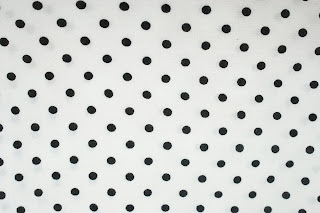The first thing that I looked at is the mathematical equations of a circle:
These equations were found from About.com
I want to look at the relationship between the sizes of polka dots, the space between and the space in which they are set in. I have worked out, using these equations, how the circumference changes as the size of the polka dot gets bigger.
If a polka dot was 0.5cm in diameter the circumference would be 0.5xpI= 1.570796
If there was a space of 100cm2 you would be able to fit 6362.14 polka dots with a diameter of 0.5 in tight together.
The size of the dots and the gap between each one can vary through polka dot patterns. The definition of a polka dot (thefreedictionary.com):
NOUN // One of a number of dots or round spots forming a pattern.
Therefore the possibilities are endless. A polka dots circumference could be 3.5cm and the spacing between each dot could be 0.5cm...etc
These are some examples of the vast array of different polka dot patterns there are. The dots can be small and far apart or large and close together, each pattern is a polka dotted design but it has a completely different feel about it. The pattern could be straight forward in terms of the formality of it but a twist could be added by using several colours, or partly filling random dots. Some polka dot patterns use other shapes within them, which can often disguise the traditional polka dot formation. A mixture of dot sizes can often be used to add another element, smaller dots generally fill the gaps between the larger dots or visor/ verser.
The polka dot formation can often change depending on what it is being used for. I have found that medium to large sized polka dots with an equal space between them are often used in fashion on clothing and accessories, whereas smaller dotted polka dot patterns are used on underwear and homeware. Personally I prefer the medium to large sized polka dot patterns as they seem to feel more like a true polka dot pattern.
These are a variation of polka dot patterns that I own, I am going to use these as a starting point to measure an average for my polka dot formulae. Im going to measure the size of the dot and the distance between them and then use info graphics to show the information I have found.
----------------
Polka dot patterns can also be used in a different context, optical illusions often used singular dots or dotted formations to create illusions to trick the brain.
This optical illusion has used dots and a combination of colours that make the brain think that the rows of dots are wobbling about. The rows of dots are in fact slightly out to one side on every other line. The red that has been used screams out from the grey background, and if you look carefully you can see that in the centre of each red spot there is a white dot. Your eye is drawn to the white dot which makes your brain think that the rows of red dots are moving, because your eyes and brain cannot focus on both.
This is a very well known optical illusion, the white dots are joined together by lighter lines which create squares with a dot on every corner. The background is black, the lines are grey and the dots are white, this causes there to be too much going on for the brain and eyes. You are often asked how many black dots there are, but in actual fact there are none.
This pattern is much like a kaleidoscope, when they are put into rows and touching it makes your eyes and brain sees them moving slowly.
On this optical illusion, because the dots have been condensed in two places, it gives a 3d effect. Which then makes you think that the 3 "3D" sections are rolling to the right. When in actual fact they are not moving at all.
------------

































No comments:
Post a Comment